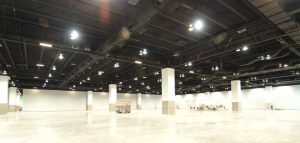Taking trade show labor services into account before finalizing your exhibit design can help make your marketing efforts more efficient and cost effective. Start by learning some basics about trade show labor services, and let that knowledge inform your design and budget decisions going forward. You may be surprised by some of the rules and regulations pertaining to setting up an exhibit at a trade show, and in business, surprises are rarely good things. Plan appropriately and well in advance, and you’ll be able to prevent unexpected expenses, and possibly take advantage of extra savings, as well.
Receiving & Storage
For larger displays, exhibitors often use the venue’s advance warehouse as an address to ship their materials to, and have it stored short-term until it’s time to set it up on the show floor. This helps ensure that all needed materials arrive in advance, and if something gets lost in transit, there’s still time to make alternate arrangements. Some exhibitors who use portable displays also use the advance warehouses in cases where freight charges are less than the cost of sending the portables as luggage on a flight with their booth team.

Trade Show Labor is an Important Part of Your Exhibit Marketing Plan
Drayage
Getting the exhibit materials your display requires to the show venue and into your booth space (drayage) are not always as simple as they seem. Some venues restrict the number of trips exhibitors can make through the venue to bring materials to their booths, and some also restrict how those materials can be carried. Most venues preclude exhibitors using a 4-wheeled cart to carry materials; some will allow 2-wheeled dollies; others only allow exhibitors to bring in what they can carry by hand. In some cases, there is a limit to the number of trips you can make to bring your materials to your booth. For many exhibits, venue rules mean that there is no choice but to hire approved help for drayage.
Venue Rules And Regulations
Making last minute changes can be painfully expensive, so make sure you find out what the specific rules are for every venue and show you’re planning to attend, and do that well in advance. There are some general rules pertaining to display heights and configurations that most U.S. venues use, but don’t just assume that every venue will use them. Look into other critical rules like set-up and teardown time frames, so you can avoid penalty charges for opening late or closing early.
Trade Show Labor & Supervision
Regulations for trade show labor vary greatly by municipality and venue, so this is one topic to research very thoroughly for every single show. Typically, if your exhibit can be set up using no tools or ladders, you will be allowed to do our own set-up, but the small details are what can trip you up. Some venues require any electrical or cabling connections to be done by a certified professional. In some cases, you may be allowed to hire your own certified installation contractor for Installation and Dismantle (I&D). Other venues require that exhibitors hire union laborers through the venue or show’s general services contractor (GSC). In cases where you’re required to hire labor through a GSC, you can protect your interests by hiring your own contractor, like Xtreme Xhibits to supervise the I&D labor and process. Having an advocate who is directly accountable to you for the successful and efficient installation of your exhibit is a wise investment in your company’s trade show marketing success.
